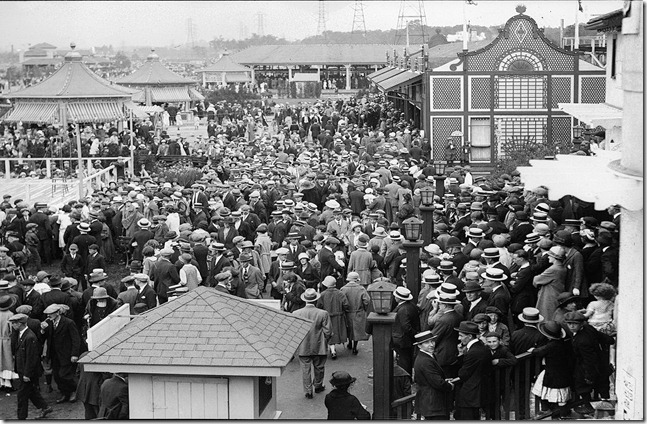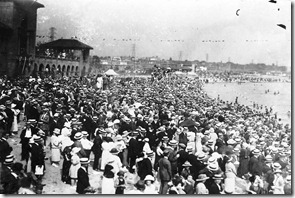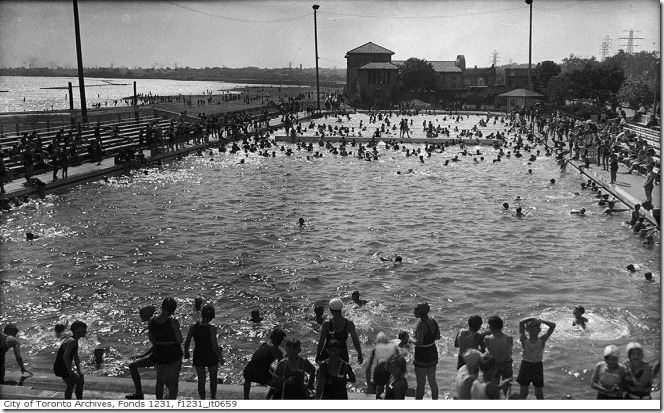Crowds at Sunnyside in the 1920s (City of Toronto Archives, Globe and Mail Fonds). Even on the hottest summer days, men wore suits, ties, and jackets when visiting the Toronto Islands, Sunnyside or even for a family picnic in a public park. Women wore hats and high-neck blouses or dresses.
In 1922, when Sunnyside was officially opened, it was the city’s latest amusement area, constructed on landfill that had been dredged from beneath the surface of Humber Bay. For many years, people said that if you hadn’t seen Sunnyside Beach, you hadn’t seen Toronto.
Some people referred to Hanlan’s Point (on the Toronto Islands) as “Canada’s Coney Island,” as it was where the city’s amusement park was located. Torontonians felt that this was ridiculous—Coney Island was, in fact, America’s Hanlan’s Point. Sunnyside also had a nickname—“The Poor Man’s Riviera”—but it was not truly representative. Although most visitors to Sunnyside were indeed of modest means, even the wealthy, including those who had cottages in Muskoka, flocked to Sunnyside whenever possible. Rich and poor alike thrilled to the resort’s alluring charms. The Scarborough Amusement Park, in comparison, had not received any special title, children referring to it simply as “the park with the diving horse.”
Though Sunnyside’s construction was not yet complete in July of 1922, the fun-seekers of the city eagerly sought the facilities that had already been built: the Parkdale Canoe Club, the Pavilion Restaurant, amusement rides, games of chance, and the numerous ice-cream and hot-dog stands. Concerts at the bandstand, lunch at the terraced tea garden, and ballroom dancing were also favourites. The bathing pavilion was nearing completion, and was scheduled to open the following month. On the far side of the pavilion, beside the lake, the wide, sandy beach was open to everyone.
Two years earlier, Boulevard Driveway—today called Lake Shore Boulevard West—had been completed, and every weekend was crammed with boxy black autos. Visitors observed the cars keenly, some silently vowing to own a vehicle as soon as possible. The traffic was directed by Sunnyside’s policemen, who wore large white helmets similar to those of London’s “Bobbies.” Toronto’s officers were almost as well-known as England’s famous brigade. They directed traffic with exaggerated hand signals, their white-gloved gestures appearing as choreographed as if it were in a theatrical production. Under construction at Sunnyside was a twenty-foot-wide wooden boardwalk that would replace an older and narrower structure. The section already completed formed a glorious promenade for strolling and showing off new attire.
During the years ahead, in early spring, visitors to the lakeside amusement park ignored the chilly temperatures as they attempted to coax the arrival of summer, Canada’s frigid winters inviting such acts of desperation. Thousands arrived to strut their stuff and display their latest outfits. Ladies sported stylish hats and gaily coloured spring coats. The men donned snappy straw boater hats. Despite the cool lake breezes, women wore their coats unbuttoned, clearly displaying their trim figures and stylish dresses. Young men’s hearts beat faster as they admired the girls, especially those who daringly wore their hems above the knee. Life was revealing more than they had ever expected.
The above quote is from “There Never was a Better Time,” a novel about two young brothers arriving as immigrants in Toronto in 1921.
Sunnyside Pool in the 1920s The beach in front of the Sunnyside Pavilion
The Sunnyside Pool when it opened in August of 1922 (all photos are from the City of Toronto Archives)
I have spent much of my adult life researching and photographing Toronto. I love the city and enjoy exploring it through my writing. One of the books, “The Villages Within”, was nominated for the Toronto Heritage Awards. If interested in novels with a Toronto setting, descriptions of the books are available by following the link: https://tayloronhistory.com/2012/03/22/toronto-author-publishes-seventh-novel/
They can be purchased in soft cover or electronic editions. All books are available at Chapters/Indigo and on Amazon.com. The electronic editions are less that $4 on Kobo and Kindle. Follow the links:
There Never Was a Better Time: http://bookstore.iuniverse.com/Products/SKU-000056586/THERE-NEVER-WAS-A-BETTER-TIME.aspx
Arse Over Teakettle: http://bookstore.iuniverse.com/Products/SKU-000132634/Arse-Over-Teakettle.aspx
The Reluctant Virgin; http://bookstore.iuniverse.com/Products/SKU-000188306/The-Reluctant-Virgin.aspx
The Villages Within: http://bookstore.iuniverse.com/Products/SKU-000175211/The-Villages-Within.aspx
Author’s Home Page: https://tayloronhistory.com/
Authors can be contacted at: [email protected]

![f1257_s1057_it0092[1] f1257_s1057_it0092[1]](https://tayloronhistory.com/wp-content/uploads/2012/06/f1257_s1057_it00921_thumb1.jpg)

